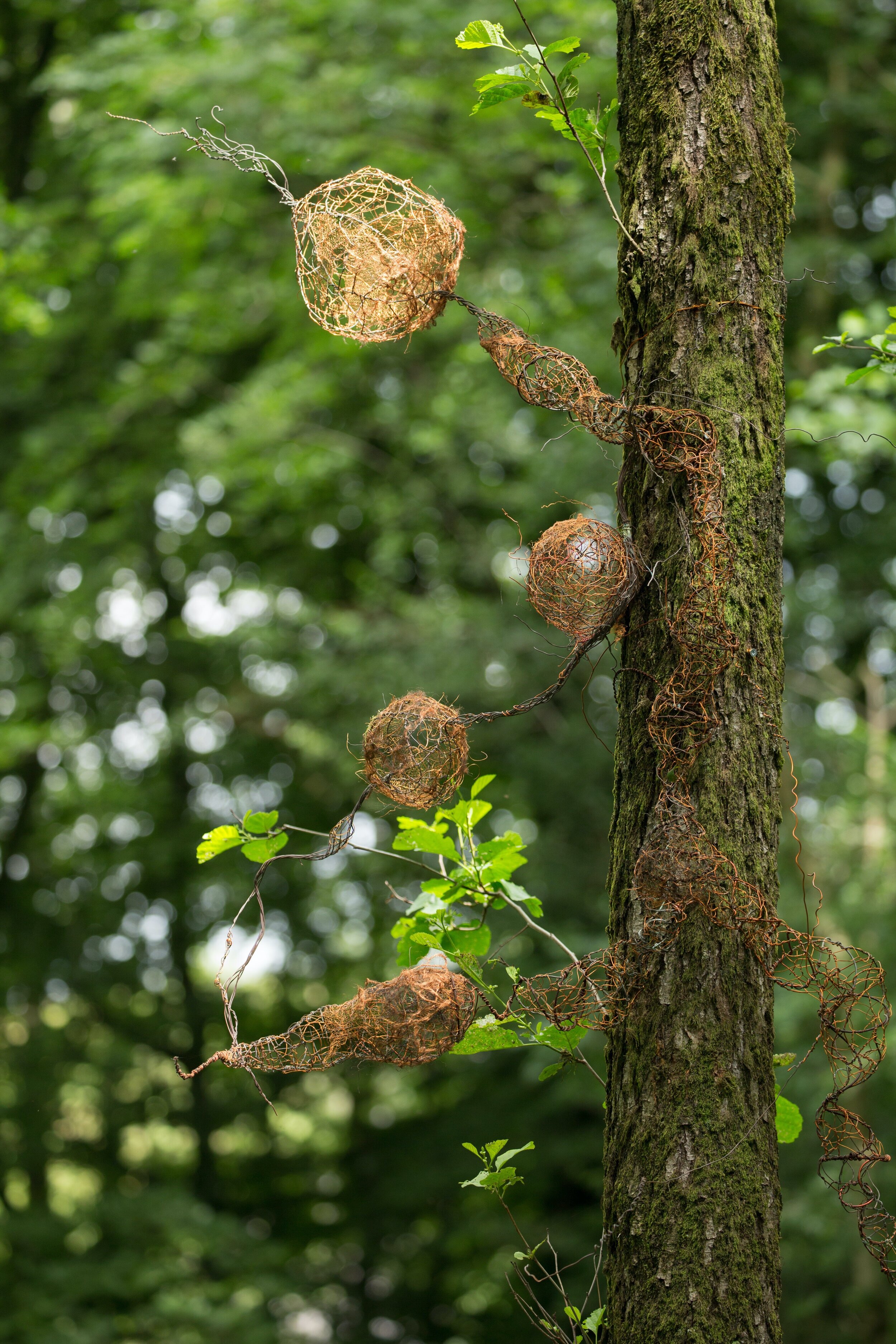











Cirri
Reclaimed steel, aluminium, copper wire, twine, wool, netting, rope
Westdown Quarry, Somerset
4m x 5m x 1.6m
2015
Photo by Duncan Simey
In 2015 Fiona Campbell was awarded Arts Council funding for an ambitious project ‘step in stone‘, involving site-specific artscapes in Mendip quarries with 14 international artists. A major multidisciplinary art event in Somerset, Fiona initiated, curated and featured in it, linking culture, environment and the community.
Fiona’s artwork for the project included a set of new works in response to the sites entitled ‘Cirri’ and ‘Eviscerated Earth’.
‘Overwhelmed by the magnitude of the quarries’ geology, nature’s tenacity, how we each impact on everything around us.
Seeds blown in to fertilise ancient, deserted rocky environments like tumbleweed. Encrusted in the rocks are fossils 350 million years old: ancient Crinoids. These fascinating creatures cling to the bottom of the seabed by long platelet stems. Others are unstalked, their long tentacle legs drag them along. Hairy filaments enable them to filter food. Imagining the Mendips under sea when vertical rockfaces formed the seabed, and their hidden history, I was captivated’. Fiona
About the Project:
Visitors encountered contemporary artworks while exploring the spectacular, wild landscapes of abandoned and working quarries in rural East Mendip. The Fourteen leading local and international artists, all with connections to the South West, created a series of site-specific artworks in response to the nature of quarries and their place in the cultural and industrial heritage of the region. Fascinating sculpture, land art, photography, textiles, painting, drawing, sound, spatial poetry and printmaking ranged from the intimate to the extravagant. A programme of workshops, guided walks and artist talks was offered to the public, in collaboration with Somerset Art Works, Somerset Wildlife Trust and Somerset Earth Science Centre. A Sculpture Design Competition was held in May 2015 to encourage young people to engage in step in stone. The winning design was translated into a sculpture in just one day with help from the artists and exhibited at SESC alongside step in stone artists’ work.
Stepped up in 3 phases over 4 months from July to October 2015, step in stone culminated in a finale fortnight as part of Somerset Art Weeks Festival ‘Momentum’. The event occupied 6 different venues including 1 working (Halecombe) and 2 disused quarries (Westdown/Asham and Fairy Cave). Black Swan Arts, Frome Museum and Somerset Earth Science Centre hosted indoor exhibitions by featured artists.
A total of 8114 visitors of all ages, local to international, visited the 6 step in stone venues and discovered fascinating sculpture, land art, photography, textiles, painting, drawing, sound, spatial poetry and printmaking ranging from the intimate to the extravagant.
In one weekend over 300 people visited the magical Fairy Cave Quarry venue. Fiona Campbell says: “Family Day was a fantastic success and really special, so many enthusiastic children, grown ups and in-betweenies enjoying the magic of Fairy Cave”
Comments from visitors include:
“In many years of visiting art events, I have never experienced anything as fascinating and inspiring as my visits to quarries today – especially this one.” (Fairy Cave Quarry)
“A wonderfully different experience”
“Wonderful – best art gallery I’ve ever been to”
“Unique and surprising”
In 2016 the work toured to Salisbury Art Centre, curated by Fiona and Amanda Wallwork.
For further information about step in stone visit www.stepinstone-somerset.co.uk
© Copyright Fiona Campbell. All rights reserved, 2021

350cms diameter
Locally found and recycled materials: reclaimed steel, aluminium, copper wire, twine, wool, netting, rope
Fiona’s inspiration is the tenacity and diversity of life and the similarities of form that occur in different organisms. This work is based on plantlike crinoids (sea lilies) - ancient sea creatures whose fossilised remains are common in carboniferous limestone and whose descendants can still be found living today. Crinoid tentacles are reminiscent of branches, tendrils, feathers or the microscopic patterns of neurons. They cling to the seabed (some now vertical rock faces) by long spiny stems, others are without a stalk but have tentacle legs or long arms to drag themselves along.

350 x 950 x 500cms
scrap steel found in quarries, wire, paper, wax, string, wool, nylon, cotton, oil
2015
Fairy Cave Quarry, Somerset
Photo Duncan Simey
A ghost cave delineating the site where it is believed connecting caves once existed between Withyhill and Hillwithy caves. Through quarrying, some caves were destroyed, others discovered. These caves are renowned for their exquisite speleothems (stalactites, stalagmites, helictites..). Photographs by Duncan Simey of the formations within and Andy Sparrow's film 'A Rock and A Hard Place' helped bring the caves to life for Fiona and provided an insight into this shattered earth.

Recycled steel and copper wire
5m (H)
Photo by Duncan Simey
Installed on a tree in the woods at Somerset Earth Science Centre, one of the step in stone venues.